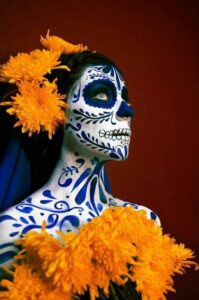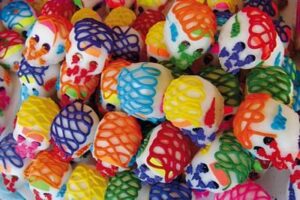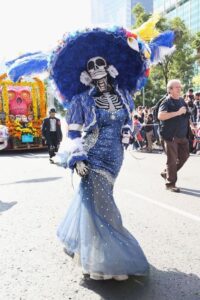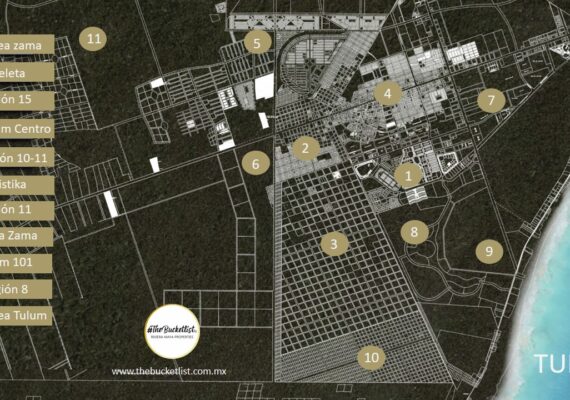We’ve all heard about the Day of the Dead or seen the classic sugar skull paintings—but what does this celebration really represent?
HERE’S ONE THING we know: Día de los Muertos, or Day of the Dead, is not a Mexican version of Halloween.
Though related, the two annual events differ greatly in traditions and tone. Whereas Halloween is a dark night of terror and mischief, Day of the Dead festivities unfolds over two days in an explosion of color and life-affirming joy. Sure, the theme is death, but the point is to demonstrate love and respect for deceased family members. In towns and cities throughout Mexico, revelers don funky makeup and costumes, hold parades and parties, sing and dance, and make offerings to lost loved ones.

WHAT IS DAY OF THE DEAD?Día de los Muertos, or Day of the Dead, is a celebration of life and death. While the holiday originated in Mexico, it is celebrated all over Latin America with colorful calaveras (skulls) and calacas (skeletons). Learn how the Day of the Dead started and the traditions that make it unique.
The rituals are rife with symbolic meaning. The more you understand about this feast for the senses, the more you will appreciate it. Here are 10 essential things you should know about Mexico’s most colorful annual event.
History
Day of the Dead originated several thousand years ago with the Aztec, Toltec, and other Nahua people, who considered mourning the dead disrespectful. For these pre-Hispanic cultures, death was a natural phase in life’s long continuum. The dead were still members of the community, kept alive in memory and spirit—and during Día de los Muertos, they temporarily returned to Earth. Today’s Día de los Muertos celebration is a mash-up of pre-Hispanic religious rites and Christian feasts. It takes place on November 1 and 2—All Saints’ Day and All Souls’ Day on the Catholic calendar—around the time of the fall maize harvest.
Altars
The centerpiece of the celebration is an altar, or ofrenda, built in private homes and cemeteries. These aren’t altars for worshipping; rather, they’re meant to welcome spirits back to the realm of the living. As such, they’re loaded with offerings—water to quench thirst after the long journey, food, family photos, and a candle for each dead relative. If one of the spirits is a child, you might find small toys on the altar. Marigolds are the main flowers used to decorate the altar. Scattered from altar to gravesite, marigold petals guide wandering souls back to their place of rest. The smoke from copal incense, made from tree resin, transmits praise and prayers and purifies the area around the altar.
Literary calaveras
Calavera means “skull.” But during the late 18th and early 19th centuries, calavera was used to describe short, humorous poems, which were often sarcastic tombstone epitaphs published in newspapers that poked fun at the living. These literary calaveras eventually became a popular part of Día de los Muertos celebrations. Today the practice is alive and well. You’ll find these clever, biting poems in print, read aloud, and broadcast on television and radio programs.

The calavera Catrina
In the early 20th century, Mexican political cartoonist and lithographer José Guadalupe Posada created an etching to accompany a literary calavera. Posada dressed his personification of death in fancy French garb and called it Calavera Garbancera, intending it as social commentary on Mexican society’s emulation of European sophistication. “Todos somos calaveras,” a quote commonly attributed to Posada, means “we are all skeletons.” Underneath all our manmade trappings, we are all the same.
In 1947 artist Diego Rivera featured Posada’s stylized skeleton in his masterpiece mural “Dream of a Sunday Afternoon in Alameda Park.” Posada’s skeletal bust was dressed in a large feminine hat, and Rivera made his female and named her Catrina, slang for “the rich.” Today, the calavera Catrina, or elegant skull, is the Day of the Dead’s most ubiquitous symbol.
Food of the dead
You work up a mighty hunger and thirst traveling from the spirit world back to the realm of the living. At least that’s the traditional belief in Mexico. Some families place their dead loved one’s favorite meal on the altar. Other common offerings:
Pan de muerto, or bread of the dead, is a typical sweet bread (pan dulce), often featuring anise seeds and decorated with bones and skulls made from dough. The bones might be arranged in a circle, as in the circle of life. Tiny dough teardrops symbolize sorrow.
Drinks, including pulque, a sweet fermented beverage made from the agave sap; atole, a thin warm porridge made from corn flour, with unrefined cane sugar, cinnamon, and vanilla added; and hot chocolate.
Costumes
Day of the Dead is an extremely social holiday that spills into streets and public squares at all hours of the day and night. Dressing up as skeletons is part of the fun. People of all ages have their faces artfully painted to resemble skulls, and, mimicking the calavera Catrina, they don suits and fancy dresses. Many revelers wear shells or other noisemakers to amp up the excitement—and also possibly to rouse the dead and keep them close during the fun.

Papel Picado
You’ve probably seen this beautiful Mexican paper craft plenty of times in stateside Mexican restaurants. The literal translation, pierced paper, perfectly describes how it’s made. Artisans stack colored tissue paper in dozens of layers, then perforate the layers with hammer and chisel points. Papel picado isn’t used exclusively during Day of the Dead, but it plays an important role in the holiday. Draped around altars and in the streets, the art represents the wind and the fragility of life.
Day of the Dead today
Thanks to recognition by UNESCO and the global sharing of information, Día de los Muertos is more popular than ever—in Mexico and, increasingly, abroad. For more than a dozen years, the New York-based nonprofit cultural organization Mano a Mano: Mexican Culture Without Borders has staged the city’s largest Day of the Dead celebration. But the most authentic celebrations take place in Mexico.








I enjoy the efforts you have put in this, appreciate it for all the great content. Tatiana Natale Heilman
Very good write-up. I definitely appreciate this website. Wenonah Beck Giess
Hurrah! After all I got a webpage from where I be able to actually obtain useful facts concerning my study and knowledge. Ginger Giles Hennie
Very good article! We are linking to this great post on our website. Keep up the great writing. Bobbette Hobey Corrine
Some truly prime articles on this web site , bookmarked. Quinta Theodore Ambert
If you desire to increase your experience only keep visiting this web site and be updated with the newest news update posted here. Evita Barnabas Sletten
Sergio, it is so nice of you to comment. I have been inspired by the way you look after your son. It makes me smile to call you my friend. Malynda Winnie Goles
A big thank you for creating such an useful article on this subject. I hope to find here more of these done by you, in the coming weeks. Janith Horst Izaak
As a Newbie, I am permanently exploring online for articles that can benefit me. Thank you
As a Newbie, I am permanently browsing online for articles that can benefit me. Thank you
I don’t even know how I ended up here, but I thought this post was good.
I do not know who you are but definitely you’re going
to a famous blogger if you are not already 😉
Cheers!
Hey very interesting blog!
This piece of writing provides clear idea designed for the new users of blogging, that truly
how to do blogging.
If you want to grow your familiarity just keep visiting
this web page and be updated with the latest news
update posted here.
Wow that was unusual. I just wrote an incredibly long comment but after I clicked submit my comment didn’t show up.
Grrrr… well I’m not writing all that over again. Anyhow, just wanted to say wonderful blog!
Really informative article.Really looking forward to read more.